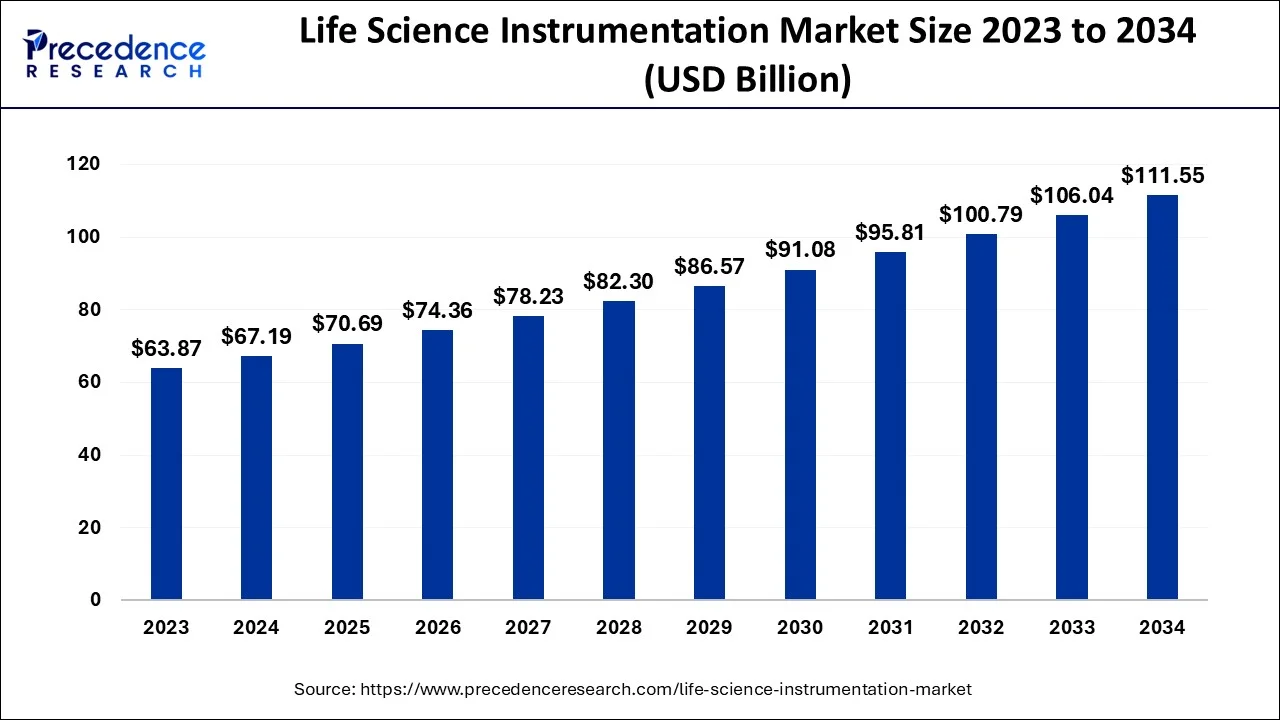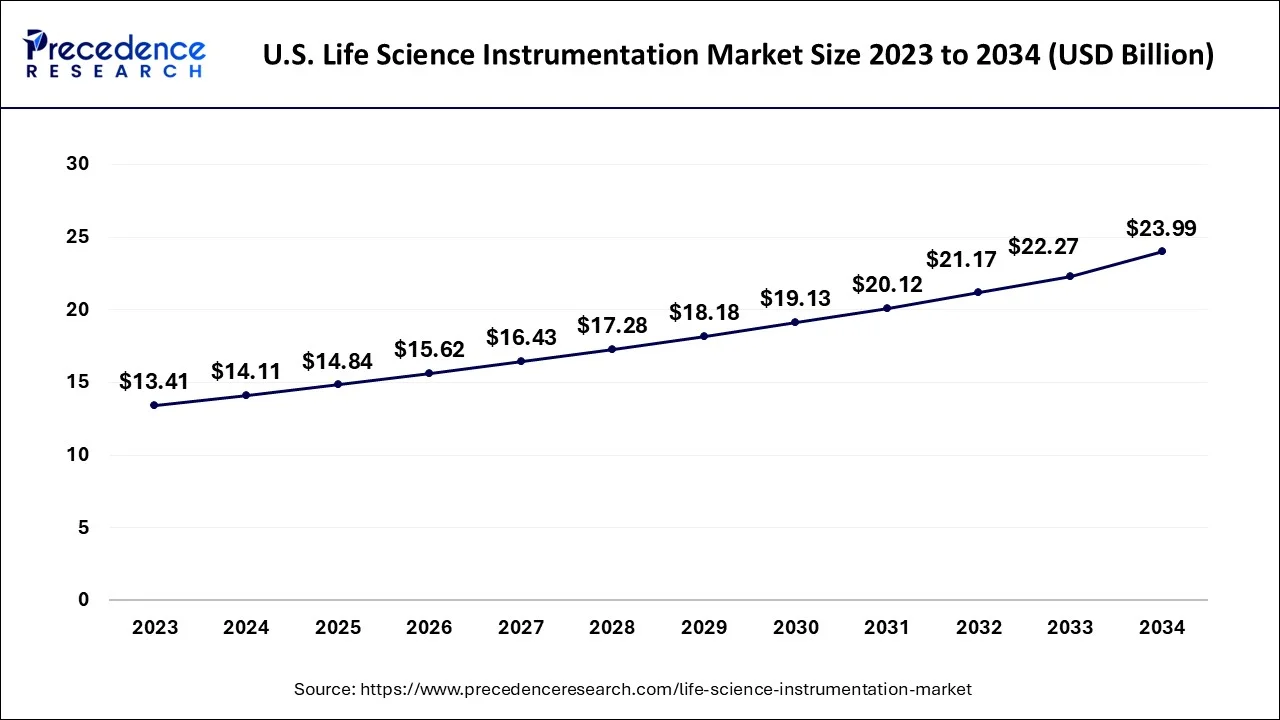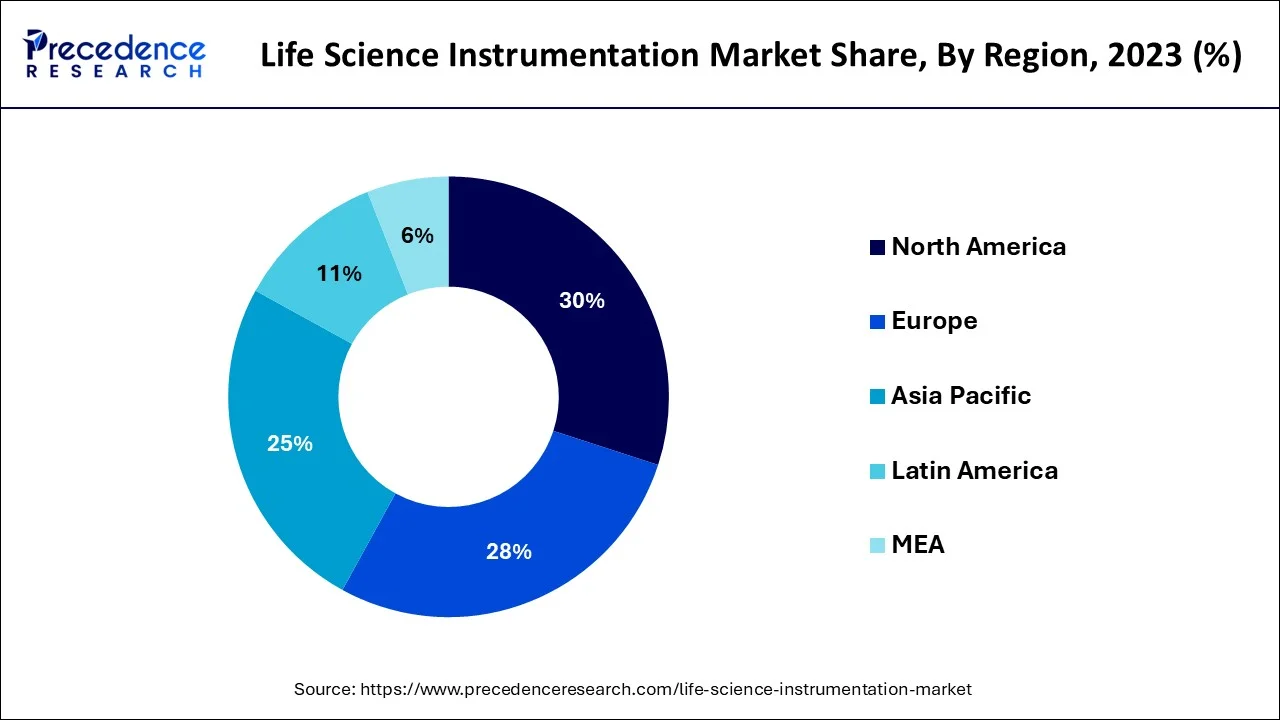June 2024
The global life science instrumentation market size is predicted to increase from USD 67.19 billion in 2024, grew to USD 70.69 billion in 2025 and is anticipated to reach around USD 111.55 billion by 2034, poised to grow at a CAGR of 5.20% between 2024 and 2034. The North America life science instrumentation market size is calculated at USD 20.16 billion in 2024 and is estimated to grow at a fastest CAGR of 5.37% during the forecast year.
The global life science instrumentation market size accounted for USD 67.19 billion in 2024 and is anticipated to reach around USD 111.55 billion by 2034, expanding at a CAGR of 5.20% from 2024 to 2034.

The U.S. life science instrumentation market size reached USD 14.11billion in 2022 and is priicted to be worth around USD 23.99 billion by 2034, at a CAGR of 5.45% from 2024 to 2034.

Based on the region, the North America segment dominated the global life science instrumentation market in 2022, in terms of revenue and is estimated to sustain its dominance during the forecast period. The life science instrumentation is employed in a variety of applications in North America. The life science instrumentation has shown to be a useful tool for a variety of applications including pharmaceutical applications, final product testing, and food safety testing.

On the other hand, in the life science instrumentation market, the Asia-Pacific region is one of the most profitable regions. The region’s growth is being fueled by strategic expansions by important market players in rising Asian countries, the growing pharmaceutical industry in China and India.
The life science instruments are commonly utilized for analytical techniques and method validation during drug development. Nowadays, several innovative technologies are used in the medication development process. The life science instrumentation market will benefit from rising demand for analytical instruments, strong growth in the biotechnology and pharmaceutical industries, and expanding application area of analytical instruments. As sequencing technologies aids in determining the origin of an illness, increased attention on next generation sequencing (NGS) is expected to promote market growth.
The life science instrumentation market is expected to benefit from an increase in research and development activities in various sectors such as biotechnology, pharmaceuticals, food and beverage, and agriculture. Moreover, the increased number of novel product launches by numerous prominent players is expected to boost the growth of the life science instrumentation market during the forecast period.
The growing incidence of chronic diseases in both developing and developed countries is projected to increase the demand for effective technology for early disease diagnosis, which will drive up the demand for instruments in life science. Furthermore, the market for life science instrumentation is being driven by increased public-private investments in life science research and technical developments in analytical equipment. However, the high cost of life science instrumentation is inhibiting the market’s expansion.
During the forecast period, the life science instrumentation market is expected to rise due to rising demand for effective diagnostic technologies and increasing government funding in the development of new instruments utilized in the life sciences and medical devices sectors. The growing applications of life science instruments in other industries, such as the food and beverage industry is expected to boost the life science instrumentation market growth during the forecast period.
The majority of life science and analytical technologies are utilized to study DNA in order to develop new pharmaceutical medications and determine food quality. The companies are heavily investing in this area in order to increase the market growth. The development of new products will improve the ability to accurately diagnose samples. It will assist in the targeting of treatment for a specific patient.
The growth of life science instrumentation market is projected to be hampered by high maintenance and operation costs. In addition, without an alternative, diagnosing the samples will be difficult because the lack of such intricate equipment would make the process much more complicated and cause the outcome to be delayed.
| Report Coverage | Details |
| Market Size in 2024 | USD 67.19 Billion |
| Market Size in 2034 | USD 111.55 Billion |
| Growth Rate From 2024 to 2034 | CAGR of 5.20% |
| Revenue Projection by 2032 | US$ 100.79 Billion |
| Largest Market | North America |
| Fastest Growing Market | Asia Pacific |
| Base Year | 2023 |
| Forecast Period | 2024 to 2033 |
| Segments Covered | Technology, Application, End User, and Region |
| Regions Covered | North America, Europe, Asia-Pacific, Latin America and Middle East & Africa |
Based on the technology, the next generation sequencing (NGS) segment dominates the life science instrumentation market during the forecast period. The next generation sequencing (NGS) segment is predicted to increase at the fastest CAGR throughout the forecast period, owing to the benefits of NGS technologies in DNA sequencing, which give much higher productivity and reduce the requirement for fragment-cloning processes. Moreover, the constant technological developments and the rising availability of less expensive sequencing platforms are likely to fuel the expansion of the life science instrumentation market.
The microscopy is expected to grow at rapid pace during the forecast period. The expanding healthcare sector, combined with rising applications from emerging economies, would further boost numerous prospects that will contribute to the development of the microscopy segment.
Based on the application, the research dominates the life science instrumentation market during the forecast period. The expanding number of research studies along with increased public-private funding in the field of genomic researches, as well as the continued trend of laboratory automation and robotics, all contributes to the substantial share of the research applications segment.
The clinical segment is expected to grow at rapid pace during the forecast period. The rising frequency of chronic disease, as well as the expanding demand for clinical trials in emerging countries, is driving the growth of segment.
Based on the end user, the pharma-biotech dominate the life science instrumentation market during the forecast period. The life science instruments are used widely in pharmaceutical and biotechnology industries. Pharmaceutical instrumentation necessitates the highest levels of precision, dependability, and quality.
The hospitals & diagnostic labs is expected to grow at rapid pace during the forecast period. The utilization of life science instrumentation in diagnostic labs and hospitals is on a large scale, owing to rising prevalence of chronic diseases and rising R&D investments.
Segments Covered in the Report
By Technology
By Application
By End User
By Geography
For inquiries regarding discounts, bulk purchases, or customization requests, please contact us at sales@precedenceresearch.com
No cookie-cutter, only authentic analysis – take the 1st step to become a Precedence Research client
June 2024
January 2025
September 2024
January 2025